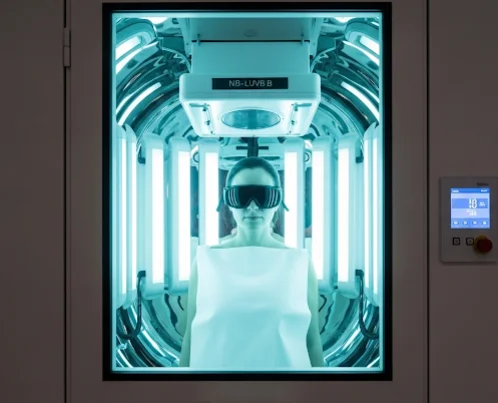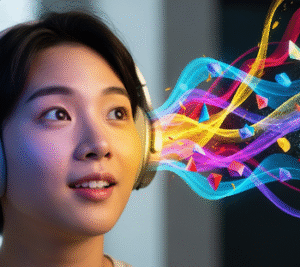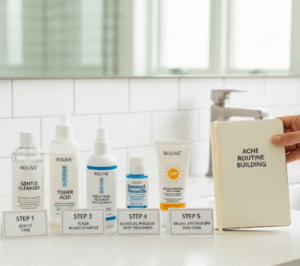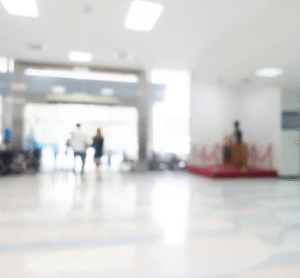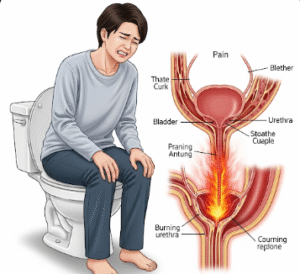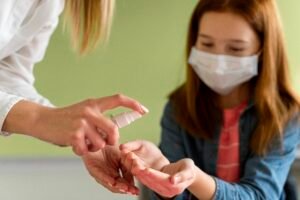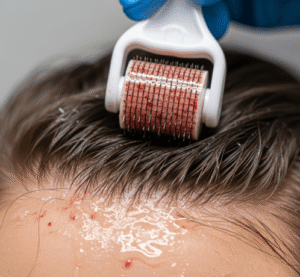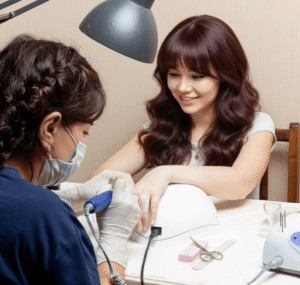➤ What it is
Narrowband Ultraviolet B (NB-UVB) phototherapy is a dermatological treatment that uses a specific wavelength of ultraviolet light (311–313 nm) to treat various skin conditions. Unlike broad-spectrum UVB, which has a wider wavelength range, NB-UVB delivers a more targeted therapeutic effect with fewer side effects.
NB-UVB therapy works by:
- Slowing down rapid skin cell turnover (useful in psoriasis, eczema, vitiligo).
- Suppressing abnormal immune activity that drives inflammatory skin diseases.
- Reducing itch, redness, and inflammation.
- Stimulating pigment cells in conditions like vitiligo.
In Korea, NB-UVB phototherapy is widely used in dermatology clinics and hospitals as part of a comprehensive skin management system. It is considered a safe, effective, and non-invasive therapy for many chronic skin conditions.
➤ Why it’s done
NB-UVB phototherapy is prescribed for:
- Psoriasis → plaque, guttate, scalp, and nail psoriasis.
- Atopic Dermatitis (Eczema) → reduces itching and inflammation.
- Vitiligo → stimulates melanocytes for repigmentation.
- Lichen Planus → helps reduce inflammatory lesions.
- Mycosis Fungoides (early cutaneous lymphoma).
- Chronic Itch (pruritus) → in kidney or liver disease.
Reasons for choosing NB-UVB:
- Non-invasive and drug-free.
- Suitable for long-term management.
- Safe for children and pregnant women (with medical supervision).
- Few systemic side effects compared to oral immunosuppressants.
In Korea, NB-UVB is especially valued because it aligns with the cultural emphasis on safe, non-invasive, and effective therapies that improve both health and skin appearance.
➤ Alternatives
Other treatment options exist, but NB-UVB is often preferred:
Topical Therapies
- Corticosteroids, calcineurin inhibitors, coal tar, salicylic acid, and vitamin D analogues.
- Effective for mild cases but limited for widespread disease.
Systemic Therapies
- Methotrexate, cyclosporine, acitretin → used for severe psoriasis and eczema.
- Biologics (adalimumab, secukinumab, dupilumab) → advanced targeted injections.
- While effective, they may carry systemic risks or higher monitoring requirements.
Other Phototherapy Options
- Broadband UVB → older, less targeted, higher side effects.
- PUVA (Psoralen + UVA) → effective but associated with more long-term risks (skin cancer, photoaging).
- Excimer laser (308 nm) → highly targeted but for localized lesions only.
Korean Dermatology Alternatives
- LED light therapy for inflammation and skin tone balance.
- Herbal compresses and calming facials as supportive treatments.
- Combination programs: NB-UVB + topical cosmeceuticals.
➤ Preparation
Preparation for NB-UVB therapy ensures safety and effectiveness:
- Medical Evaluation
- Dermatologist assesses diagnosis, severity, and suitability.
- Skin type and history of sun sensitivity are reviewed.
- Skin Care Adjustments
- Avoid applying perfumes, deodorants, or photosensitizing creams before treatment.
- Stop tanning or unnecessary sun exposure.
- Moisturize regularly to improve light penetration.
- Eye and Skin Protection
- Protective goggles are mandatory.
- Sensitive areas (e.g., genitals) may be shielded.
- Korean Clinic Preparation
- Many clinics include pre-treatment calming masks or hydration sprays.
- Patients are given digital skin analysis to monitor progress.
➤ How it’s Done
NB-UVB therapy in Korea is performed under strict dermatology supervision:
Step 1: Patient Entry
- Patients enter a phototherapy booth equipped with special NB-UVB lamps.
- Alternatively, targeted hand/foot devices may be used.
Step 2: Protective Measures
- Goggles worn for eye protection.
- Sensitive areas covered.
Step 3: Light Exposure
- Sessions last from 30 seconds to several minutes, depending on skin type and tolerance.
- Light dose is gradually increased over sessions.
Step 4: Frequency
- Typically 2–3 times per week.
- Treatment courses last from 6–12 weeks, depending on condition.
Step 5: Korean Dermatology Additions
- Many clinics pair NB-UVB with:
- Hydration facials or calming creams post-session.
- LED red light therapy for recovery.
- Customized skincare regimens to maximize results.
➤ Recovery
Recovery from NB-UVB is straightforward, with minimal downtime:
- Short-term effects → mild redness, dryness, or itching, which subside quickly.
- Long-term effects → gradual clearance of plaques, improved pigmentation, reduced itching.
Aftercare Instructions:
- Moisturize frequently to combat dryness.
- Avoid sun exposure on treatment days.
- Use sunscreen daily to prevent burns or pigmentation.
- Report any unusual blistering or irritation to the dermatologist.
Korean Recovery Practices:
- Barrier-repair creams applied after each session.
- Whitening or pigmentation facials if dark spots occur post-therapy.
- Routine follow-ups with digital skin imaging to track progress.
➤ Complications
NB-UVB is generally safe, but potential side effects include:
- Mild sunburn-like redness.
- Temporary itching or dryness.
- Freckles or pigmentation changes.
- Very rare → long-term risk of photoaging or skin cancer (much lower than PUVA).
Korean dermatologists minimize risks through:
- Careful dose adjustments per skin type.
- Frequent monitoring with imaging tools.
- Combining NB-UVB with cosmetic aftercare to protect skin integrity.
➤ Treatment Options in Korea
NB-UVB therapy in Korea is widely available and highly advanced.
Why Korea excels:
- High-tech booths and devices designed for targeted or whole-body therapy.
- Integration with skincare → sessions paired with facials, masks, and barrier creams.
- Aesthetic-conscious care → pigmentation and cosmetic concerns addressed alongside medical treatment.
- Holistic dermatology → stress, diet, and skincare incorporated into long-term plans.
Unique Korean Practices:
- Digital monitoring systems track skin improvements.
- Combination care → NB-UVB + biologics or topical regimens.
- LED and herbal therapies offered post-session for comfort.
- Medical tourism programs → international patients receive NB-UVB combined with Korean skincare regimens.
✨ Final Thoughts
Phototherapy (NB-UVB) in Korea is not just a medical treatment — it’s part of a comprehensive skin health strategy. With its ability to control psoriasis, eczema, vitiligo, and other chronic conditions, NB-UVB is a cornerstone of dermatology worldwide.
Korea enhances this therapy with advanced technology, cosmetic aftercare, and holistic programs, ensuring patients achieve both medical relief and aesthetic improvement.
This integrated model makes Korea one of the leading destinations for NB-UVB therapy, combining science, skincare, and cosmetic excellence.

